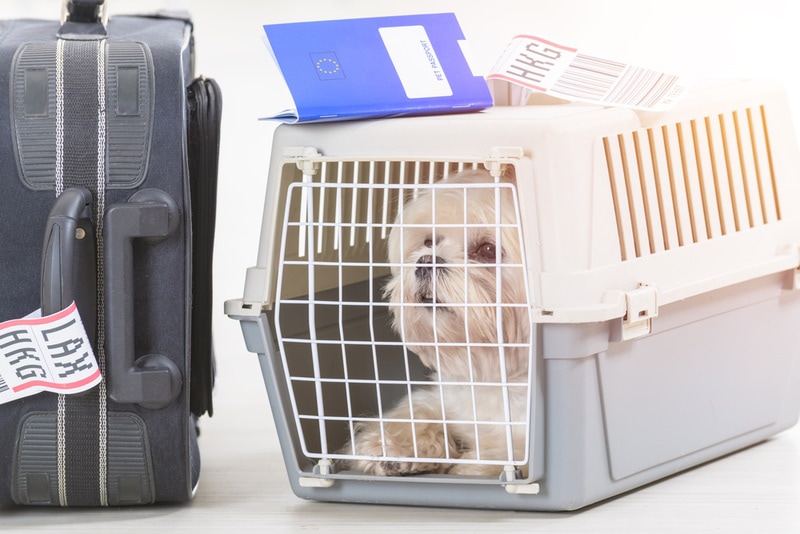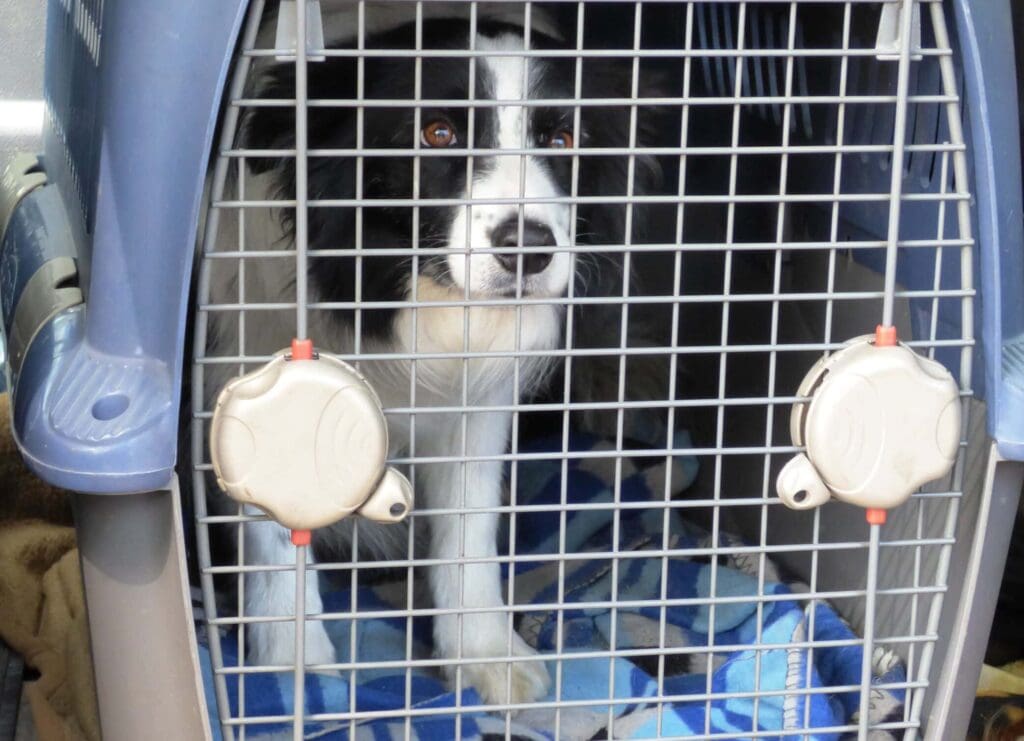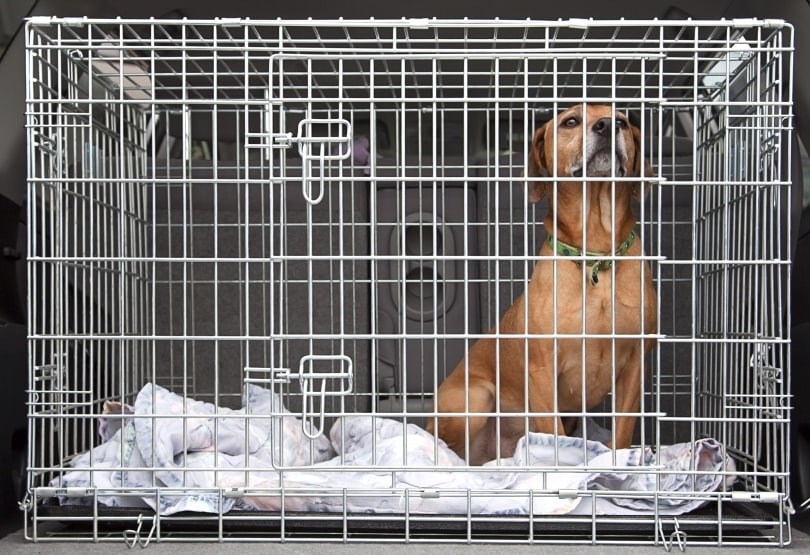How Much Does It Cost to Fly a Dog Internationally (2024 Price Guide)
By Jessica Kim
Updated on

Click to Skip Ahead
There’s a lot that goes into traveling internationally with dogs. It’s an added hurdle for travel planning, and it’s important to include pet flight expenses in your travel budget because they can cost anywhere between a couple of hundred dollars to thousands of dollars.
Along with paying for pet transportation fees, you’ll have to budget for physical exams and pet travel gear. Prices will also vary depending on your dog, and in most cases, flying internationally is significantly more expensive the larger your dog. Here are some key expenses you can expect to budget for if you plan to fly internationally with your dog.
The Importance of Preparation For Flying Internationally With Dogs
There’s no denying that flying internationally with dogs can be stressful because of all the moving parts that are involved. You need the proper documentation to ensure both you and your dog are able to pass through customs, and you’ll have to pack additional travel supplies to make the trip as comfortable as possible for your dog.
Therefore, it’s essential to start preparing for international travel as soon as you have your travel destination. Make sure to first look through your destination country’s pet travel laws. Different countries will have their own policies on the types of pets that are allowed within their borders and the required travel documents that you must bring with you. Many countries require proof of vaccination and other health standards. So, make sure to set aside enough time to complete veterinary care appointments and gather all the required documents for pet travel.
It’s also important to look up international airline companies that accommodate pets and have a clear understanding of their pet travel policy. Some airline companies won’t allow pets to travel in their cargo, while others won’t board pets on flights to certain countries. Since airline companies can change their pet policies at any time, it’s best to contact airline companies directly to ensure you have the most updated pet travel policies.

How Much Does Flying Internationally With a Dog Cost?
There are several costs to consider when flying internationally with a dog. You’ll have to consider paying fees for physical health exams, vaccinations, travel application fees, and airline company pet travel fees.
Your budget will also depend on how you plan to transport your dog. The cheapest fees are often in-cabin flights, but this option is only available for small dogs. Some airlines can transport larger dogs in their cargo space, or you can look into hiring a pet shipping company.
Here are some costs that you can expect to pay when traveling internationally with your dog. Note that some costs, particularly for veterinary services prior to traveling, will vary based on several factors. The costs provided are just an estimate.
| Item | Cost |
| Veterinary Physical Exam | $75 |
| Rabies Vaccine | $70 |
| Fecal Exam | $50 |
| Microchipping | $50 |
| USDA Endorsement Fee | $38 |
| Airline Pet Travel Fee (in-cabin) | $100–$200 |
| Airline Pet Travel Fee (cargo) | $1,000 |
| International Pet Shipping Company | $2,500–$3,000 |
Additional Costs to Anticipate
It’s important to be prepared to spend money on pet travel gear. The most significant pet travel equipment will be your dog’s travel crate. Travel crates must meet specific size requirements, and you can obtain these requirements by asking the airline company. Some airline companies may also be able to provide recommended brands.
It’s also a good idea to invest in travel food bowls and a pet travel bag to keep all of your dog’s supplies organized and in one space. Make sure to include a bag of your dog’s favorite treats and some calming products to soothe travel anxiety.

When Should You Start Preparing to Travel Internationally With Your Dog?
It’s best to start travel planning as soon as possible. Most countries have at least the following traveling requirements:
- Health check from a federally-accredited veterinarian
- 7001 USDA-APHIS Form issued and endorsed by a federally-accredited veterinarian
- 7001 USDA-APHIS Form issued and endorsed by the USDA
It’s helpful to review the International Animal Export Regulations issued by the US Department of Agriculture – Animal Plant and Health Inspection Service (USDA-APHIS). This will help you to familiarize yourself with the rules and regulations of international travel with pets.
It’s also important to call the embassy of your destination country to confirm the country’s travel laws and the required documents for entry. Keep in mind that some countries can have long quarantine periods for pets.
Once you have a clear set of requirements, schedule an appointment with a federally-accredited veterinarian to get started on submitting your travel paperwork. Keep in mind that paperwork processing times will vary depending on the country, and you can expect application processing to take at least several weeks.

Does Pet Insurance Cover International Travel With Dogs?
Pet insurance does not cover the general cost of traveling with dogs. However, there are some cases in which pet insurance will cover accidents and injuries during international travel. It will depend on your pet insurance company and their policy in covering veterinary care expenses from abroad. Some pet insurance companies will reimburse medical bills from any veterinary care clinic around the world, while others will restrict their coverage to clinics located in the US. So, it’s important to check with your pet insurance company to receive accurate information regarding international travel with dogs.
If you don’t want to enroll your pet in a pet insurance plan, you could opt to enroll in a pet travel insurance plan. Pet travel insurance plans only offer coverage for the duration of your trip, including pet transportation. The range of coverage will depend on the pet insurance company, but you can expect pet travel insurance to cover common travel issues, like motion sickness, unexpected injuries for pets traveling in cargo, heat stroke, and hypothermia.
What to Do for Your Dog Before Traveling
One of the best ways to help your dog is to remain calm through travel planning and during your flight. Dogs can pick up on their owner’s emotions and can start to feel stressed if they sense their owner’s stress. So, being mindful of your own stress levels throughout the travel planning process will help both you and your dog immensely.
You can also help your dog get used to traveling by practicing using their travel crate. It’ll be good to brush up on crate training and make the travel crate a safe space for your dog. You can do this by placing your dog’s favorite toys and treats in the crate and serving your dog’s meals inside it.
It can also be helpful to test out a few pet-calming products before your travel start date to see which ones work with your dog. These types of products are typically infused with a calming essence, such as chamomile or lavender, and can come in the form of collars, sprays, or supplements.

Conclusion
The costs for flying your dog internationally will vary significantly depending on your dog’s size and the type of transportation you choose. The most significant expenses will come from physical health exams and pet transportation fees. Having pet insurance may help you pay for some of these costs and any accidents and illnesses that occur during your trip. However, it most likely won’t pay for routine care costs and airline pet travel fees.
Featured Image Credit: Monika Wisniewska, Shutterstock











